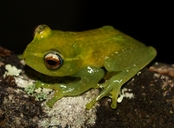|
Description
A green, rather small treefrog; males
24-28 mm SVL, females unknown. Back light green, sometimes with yellowish reticulations
and often with dark spots. Two yellowish stripes from snout through eye to the
neck. Belly whitish. Iris silvery golden with an orange-brown area around the
pupil. Iris periphery is blue. Skin on the back smooth. White lateral fringes
along lower arm and tarsus. Nostrils somewhat closer to tip of snout than to the
eye. Tympanum/eye ratio is 0.46-0.69. Tibiotarsal articulation reaches at maximum
the nostrils. Webbing of the hand: rudimentary between 1 and 2i, 2e(1), 3i(2),
3e(1), 4(0.5-1); webbing of the foot 1(0), 2i(1), 2e(0), 3i(1), 3e(0), 4i/e(1),
5(0). Males with a nuptial pad on the first finger (not clearly visible) and
single, largely extensible, subgular vocal sac.
Similar species: The other known species of the Boophis luteus-group
are larger and differ by colouration in life. In preservative, specimens with dark pigment on the back can resemble B. sibilans. In males of the rappiodes-group, the tibiotarsal articulation reaches beyond tip of snout when the hind limb is brought forward.
Distribution and Habitat
Country distribution from AmphibiaWeb's database: Madagascar
Ambohitantely, Antoetra (Antratrabe, Soamazaka, Vohisokina), Col des Tapias, Farihimazava, Imaitso forest, Itremo, Ivohibe, Mandraka, Manjakatompo. It occurs between 1,200-1,800m asl in high-elevation rainforest. It also inhabits degraded areas and open habitats (Nussbaum et al. 2008).
Life History, Abundance, Activity, and Special Behaviors
Calling males were found mainly after sunset along streams
in primary forest, sitting 1-2 m high in the vegetation. Single males in the
Andringitra mountains started calling as early as 16:00 in the afternoon.
Call (from the terra typica): A series of regularly repeated unharmonious
croaky notes that can last at least about 1 minute. Note duration is 140-150
ms, duration of intervals between notes is 240-270 ms. Note repetition rate
is 2.5/s. The notes are pulsed; about 20 pulses per note are recognizable on
the oscillogram. Frequency ranges from 2.2 to 3.5 kHz. Calls from Andringitra
are very similar (note repetition rate 2.5/s, frequency 2.2-3 kHz).
Eggs and tadpoles (from the terra typica): Tadpoles were found in
a larger fast-flowing brook near the place where the males were calling. It is very probable that they belong to Boophis ankaratra. Total
length of two tadpoles in stage 27 was 32-33 mm, body length was 12 mm. Mouth
very large, tooth formula 4/4+4//3. The belly was silvery, the tail was mottled
with dark. We reared one tadpole to a froglet, which was light green with some
dark spots on the back after metamorphosis. It metamorphosed in January
and measured 13 mm.
Breeding takes place in fast moving streams (Nussbaum et al. 2008).
Trends and Threats
Least Concern: wide distribution and tolerance of habitat modification. It occurs in Parc National d'Andringitra and the Réserve Spéciale d’Ambohitantely (Nussbaum et al. 2008). Possible reasons for amphibian decline General habitat alteration and loss
Habitat modification from deforestation, or logging related activities
Intensified agriculture or grazing
Urbanization
Habitat fragmentation
Comments
Taken with permission from Glaw and Vences (2007).
References
Glaw, F. and Vences, M. (1994). Amphibians and Reptiles of Madagascar. M. Vences and F. Glaw Verlags GbR., Köln.
Glaw, F., and Vences, M. (2007). Field Guide to the Amphibians and Reptiles of Madagascar. Third Edition. Vences and Glaw Verlag, Köln.
Nussbaum, R., Vences, M., and Andreone, F. (2008). Boophis ankaratra. In: IUCN 2008. 2008 IUCN Red List of Threatened Species. www.iucnredlist.org. Downloaded on 14 April 2009.
Originally submitted by: Miguel Vences and Frank Glaw (first posted 2000-10-24)
Edited by: Henry Zhu (2010-07-19)Species Account Citation: AmphibiaWeb 2010 Boophis ankaratra <https://amphibiaweb.org/species/4332> University of California, Berkeley, CA, USA. Accessed May 31, 2025.
Feedback or comments about this page.
Citation: AmphibiaWeb. 2025. <https://amphibiaweb.org> University of California, Berkeley, CA, USA. Accessed 31 May 2025.
AmphibiaWeb's policy on data use.
|
